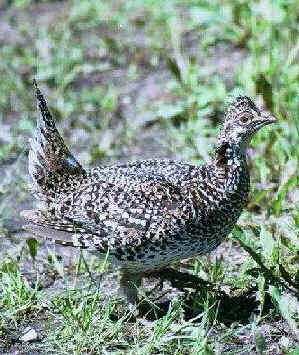
Used with permission. © Robert McDonald
Thanks to Robert for allowing us to use this picture.
Sharp-tailed Grouse
(Genus, species: Tympanuchus phasianellus)
The sharp-tailed grouse are one of the larger grouse. They have sharp pointed tails which stick straight up when the birds are displaying. They are often mistaken for their cousin, the prairie chicken.
One of the more interesting details of the sharp-tailed grouse relates to their courting rituals. The males gather on a group breeding ground called a lek and show off (or display) for the females.
When displaying, the males point their tails up, spread their wings, hold their heads low, and stamp their feet in a sort of stutter-dance that looks a lot like an airplane trying to take off. The males of a community all dance at the same time as a part of their battle over territory and to impress females.
First Nations people call the sharp-tailed grouse the "fire bird" because their habitat was kept open by fires that killed trees and shrubs.
The Lek: The Lek is one of the most important parts of sharp-tail life. Reduction of suitable Lek locations has caused the decline of sharp-tailed grouse in some areas. The Lek is an elevated patch of native grasslands that ranges from the size of a small house to that of a baseball diamond -- the elevation enables them to spot predators at a distance. The grouse live in communities with up to two dozen males "displaying" in one Lek. A community's Lek is used for years... even decades.
The male birds spend the fall and winter dividing up the Lek into individual areas -- with the dominant males located near the center of the Lek. When spring arrives, things get even more competitive and the males may even peck at each other to keep or expand their territorial boundaries -- especially when females wander through the area.
The main purpose of the Lek is to provide an area for the males to display their dancing ability to the females. The strongest and fittest males dance in the center of the Lek. The longer and stronger the bird is able to dance, the more impressed the female is. During the dance, many of the males must take breaks to rest... Those that rest the least and dance the fastest are dominant and preferred by the females.
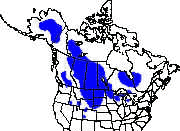
General: The sharp-tailed grouse is found mainly in South-Western Canada and the Northern United States.
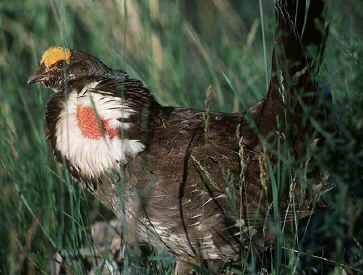
Photographer: Bates Littlehales
Description - female: Very much like the male but without the yellow eyebrows and purple air sacs.
Description - chicks: The chicks have the same mottled brown and grey camouflage as their parents but their heads are quite yellow.
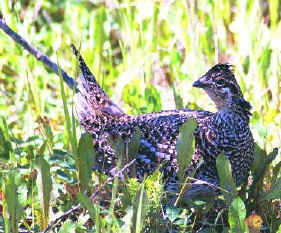
Used with permission. © Robert McDonald
Feeding: The sharp-tailed grouse are mainly vegetarians although they do eat some insects during the summer. Their plant diet include seeds, leaves, grains, berries, buds and flowers.
Habitat: Sharp-tailed grouse live mainly in prairies, grasslands, agricultural areas and open woodland habitats. They usually live in more open, grassy areas during the summer and sheltered, wooded areas during the winter.
Nesting: The sharp-tailed grouse nests in May and June. The female selects a male partner during the display period in spring but nests alone afterward. The nests are on the ground usually under shrubs or grass. The nests are shallow depressions lined by feathers, ferns or grass.She lays an average of 10 to 14 eggs (ranging from 5-17). After hatching, the young quickly leave the nest, but the mother keeps tending the young and leads them to feeding areas. The young feed themselves when they reach these areas.
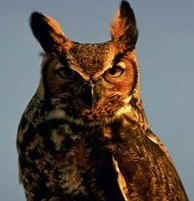
Enemies: Great horned owls, goshawks, foxes, skunks and raccoons all prey on sharp-tailed grouse. They are also hunted for sport.
As well, many historical Lek areas have been turned into agricultural areas. The lack of native grasslands keeps them from having a strong, continued population in some areas.
Migration: The sharp-tailed grouse do not have significant migration habits, though they do move from the more open, grassy areas in the summer to treed areas during the winter.
Worksheets and Other Activities:
- Saskatchewan provincial bird coloring page (with information)
- Saskatchewan provincial bird with labels (with information)
- Sharp-tailed Grouse Coloring Page (from coloring.ws)
- "What I've learned about the Sharp-tailed Grouse" Coloring Worksheet
- Help the Sharp-tailed Grouse find his supper Maze
- How many words can you make from Sharp-tailed Grouse Word Worksheet